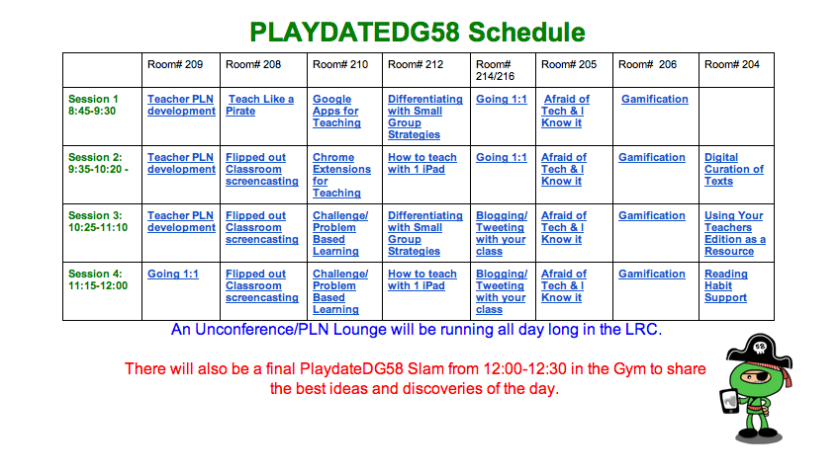In a matter of weeks schools will be opening in my state and across the nation. Most students and teachers are anticipating a smooth start to a new school year. For me, this summer has been full of opportunities to hone in my teaching practice and expand my PLN. Reading Teach Like a Pirate and attending Playdatedg58 were two opportunities that stretched my thinking in preparation for a new school year. This post is based on what I’ve learned through these events/activities.
1. Teachers have control (for the most part) and can take risks in the classroom
The experiences that I highlighted above have brought insight to the idea of teacher control in/out of the classroom. Teachers often have more control in their classroom than many educators would like to admit. Besides the curriculum given to the teachers by administration, how much input do teachers have in how their classroom is constructed/run? Speaking from an elementary teaching perspective, teachers have quite a few opportunities to modify their classroom environment. Middle and high school may be a bit different as more than one teacher is in one classroom throughout a day.
The concept of instructional academic freedom often gives teachers the ability to teach how they feel best engages students in the learning process. Of course this depends on how academic freedom is interpreted. The book Teach Like a Pirate has reminded me that educators can take risks in their classroom. Trying out a new teaching strategy can bring fruitful results. Creating lessons that with unique hooks can engage students in new and exciting ways. Students are more likely to retain and apply knowledge when their learning experiences are memorable. Moving outside of general lesson plans that are often created by publishing companies, gives teachers the ability to differentiate lessons based on students’ needs. Engaging lessons might include lots of conversations, noise, excitement, wonder, curiosity, disarray … but also learning. This may not always the norm in your building or school but I feel that action is needed to move beyond standardizing all schools, classrooms and students.
Now, I understand that not all teachers feel this way. Some are in organizations that mandate specific teaching protocols that may limit teacher academic freedom in the classroom. Also, some teachers may feel that they are unable to take these types of risks in the classroom because of expectations from administration. If you find yourself in a situation where taking a teaching risk isn’t the norm, feel free to speak with your administration about the benefits of your idea. Within reason, most administrators will support the enthusiasm and ideas that a teacher brings to the table.
2. Give the control back to the students
Many of the teachers that I met at Playdatedg58 seemed to feel comfortable creating engaging learning opportunities for their students. I’ve found that most teachers want students to become intrinsically motivated to do their best. That motivation is vital in enabling student ownership in the classroom. I’ve found that materialistic motivators to be less than stellar in developing student ownership. Moving beyond materialistic rewards also communicates that some of the satisfaction gained from learning and accomplishing tasks is internal.
I remember being a student and rarely having input in classroom decisions. It was informally communicated that the teacher was in control of what/how I learned, resulting in close to zero student ownership. The near 100% teacher direct instruction didn’t help my situation. Fortunately this changed for the better as I progressed through elementary school. I believe that giving students the opportunity to make decisions in the classroom is important. It also communicates that the teacher has created an environment where there is trust between the students and teacher. Creating that climate of trust is essential for student ownership.
How do educators create an environment where students feel comfortable and are encouraged to take ownership of their own learning?
Keep in mind that this list is designed for elementary students, but I’m sure it could apply to other grade levels.
Students are given opportunities to …
- Make classroom decisions – rubrics, what problems/assignments to complete
- Set expectations – set rules for class
- Set goals – analyze their performance, set personal goals, monitor progress along way
- Give/offer feedback – use plus/delta, quality tools, reflect and offer input regarding learning
- Publish their writing – use blogging platforms to publish/scan in digital works
- Use social media – Tweet , Vine, Instagram, Twitpic throughout day/week/month
- Participate in Student jobs – electrician, technician, paper passer, etc.
- Journal – reflect on progress made and respond to written feedback by teacher
- Setup the classroom – help in arranging classroom setup
- Respectfully debate – participate in conversations about most effective way to solve ______.
I believe that a classroom is a community of learners. To accomplish some of the tasks above teachers need to be able to step back and give students opportunities to take control/ownership. Many new teachers that I’ve encountered feel that if they allow students opportunities to express themselves they won’t be able to regain control and that will negatively impact their evaluations. I’m sure many educators have heard the sarcastic phrase “don’t smile till January” or something like that. I’ve found that giving students opportunities to control their learning also benefits the entire classroom community. Giving up some control in the classroom means that educators are willing to take a risk and create a classroom environment that enables students to take responsibility for their own decisions.
48.782320
9.177020









